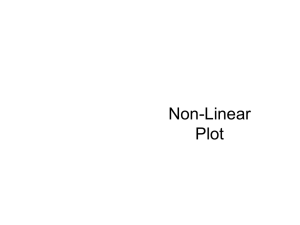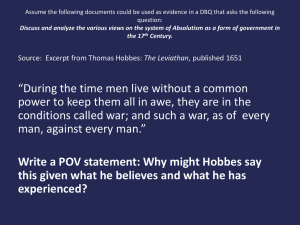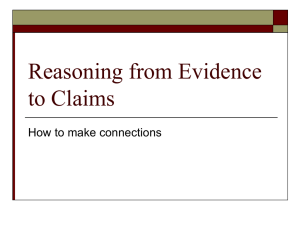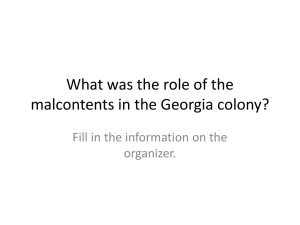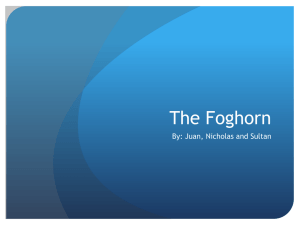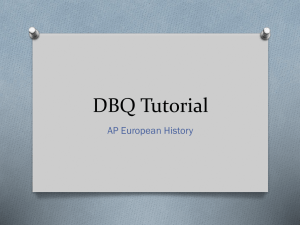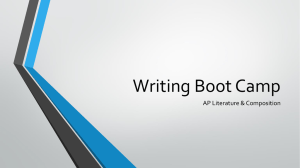Final Jeopardy
advertisement
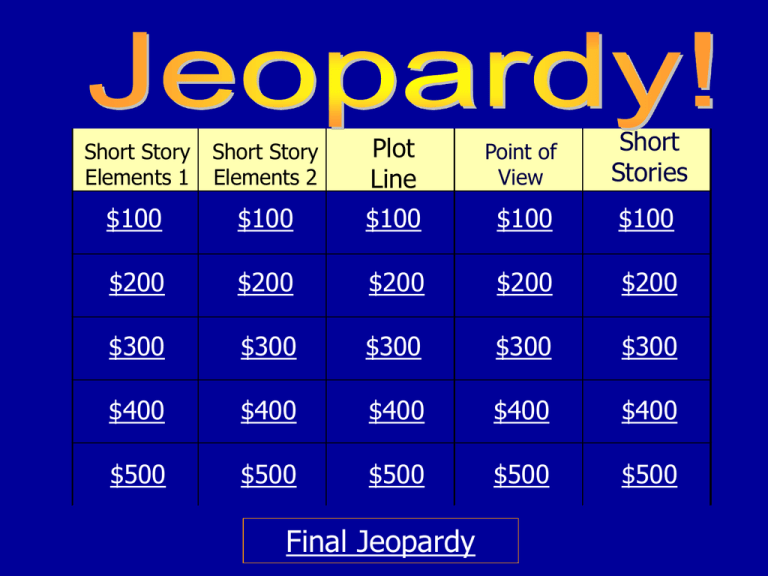
Short Story Elements 1 Short Story Elements 2 Plot Line Point of View Short Stories $100 $100 $100 $100 $100 $200 $200 $200 $200 $200 $300 $300 $300 $300 $300 $400 $400 $400 $400 $400 $500 $500 $500 $500 $500 Final Jeopardy $100 Question from Elements 1 A contrast between what is expected and what actually happens or exists? $100 Answer from Elements 1 Irony $200 Question from Elements 1 The techniques a writer uses to develop characters. $200 Answer from Elements 1 Characterization $300 Question from Elements 1 A series of related events that happen in a story. $300 Answer from Elements 1 The Plot $400 Question from Elements 1 The feeling or atmosphere created when reading a story is called this. $400 Answer from Elements 1 Mood or Tone $500 Question from Elements 1 Hints or clues provided by the author that the reader can use to predict what may happen in a story. $500 Answer from Elements 1 Foreshadowing $100 Question from Elements 2 It’s what the main character in a story is called (it’s who we identify the most with). $100 Answer from Elements 2 Protagonist $200 Question from Elements 2 It’s the type of conflict in which a character struggles with another person or force outside of him/herself. $200 Answer from Elements 2 External Conflict $300 Question from Elements 2 This type of irony is when the audience/reader knows something the characters do not. $300 Answer from Elements 2 Dramatic Irony $400 Question from Elements 2 These type of characters change from the beginning of a story to the end. $400 Answer from Elements 2 Dynamic Characters $500 Question from Elements 2 Most stories are written in time order. This is called ______ order. $500 Answer from Elements 2 Chronological Order $100 Question from Plot Line This is what is known as the high point of the story – it’s the point of highest tension. $100 Answer from Plot Line The Climax $200 Question from Plot Line This part of the plot line is when the author gives the background information needed to set up the story. $200 Answer from Plot Line The Exposition $300 Question from Plot Line This part of the plot line immediately follows the climax – it’s when the solution to the problem starts. $300 Answer from Plot Line Falling Action $400 Question from Plot Line It’s when the story jumps back and forth in time – the story is out of time order. $400 Answer from Plot Line Flashback $500 Question from Plot Line Exposition, Conflict, Rising Action, Climax, Falling Action, and Resolution are all parts of this. $500 Answer from Plot Line The Plot Line $100 Question from POV These types of pronouns let us know the story is in First Person POV (the narrator is a character in the story). $100 Answer from POV I, me, we, us, myself, ourselves, etc. $200 Question from POV In this type of POV, the narrator knows the thoughts and feelings of ALL the characters in the story $200 Answer from POV rd 3 Person Omniscient $300 Question from POV This POV can only report on things that can be observed. It cannot get into any characters’ thoughts or feelings. $300 Answer from POV rd 3 Person Objective $400 Question from POV It’s the POV in which the narrator knows the thoughts and feelings of only one character, but the narrator is NOT a character in the story. $400 Answer from POV rd 3 Person Limited $500 Question from POV It’s what separates 1st Person POV from rd 3 Person POV. $500 Answer from POV Whether or not the narrator is a character in the story. $100 Question from General Space In “The Lottery,” the author hints that something strange is going to happen later in the story. This “hint” is called: $100 Answer from Short Stories Foreshadowing $200 Question from Short Stories In “The Catbird Seat,” Mr. Martin struggles with his own idea to kill Mrs. Barrows. The fact that he struggled with himself is what kind of conflict? $200 Answer from Short Stories Internal Conflict $300 Question from Short Stories This is the type of irony at the end of “The Lottery.” $300 Answer from Short Stories Irony of Situation $400 Question from Short Stories In “Miss Brill,” we see the thoughts and feelings of only Miss Brill, but it’s not a 1st Person POV account. What is its POV? $400 Answer from Short Stories rd 3 Person Limited Omniscient $500 Question from Short Stories What is the climax of the short story, “The Monkey’s Paw?” $500 Answer from Short Stories When the mother opens the door, and her son has disappeared after the father’s third and final wish. Final Jeopardy Question Why do so many famous short stories end so tragically or unexpectedly? Final Jeopardy Answer The tragic/unexpected endings are better remembered by the reader – it’s what makes them stand out and be remembered.
